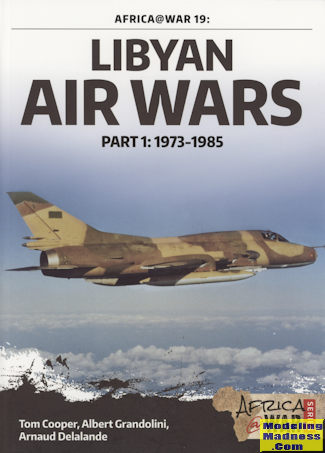 When
it comes to Libya, most American readers will concentrate on two events in the
1980s as well as the recent overthrow of the nation's strong man and the
devolution of its government into virtual chaos (which seems to happen in this
part of the world when a dictator is overthrown with the help of western
forces).
When
it comes to Libya, most American readers will concentrate on two events in the
1980s as well as the recent overthrow of the nation's strong man and the
devolution of its government into virtual chaos (which seems to happen in this
part of the world when a dictator is overthrown with the help of western
forces).
However, Libya has been in conflict with its neighbors
for a considerable time, particularly when Muammar Gadaffi took over power in a
coup in 1969. It was about this time that oil companies found considerable
resources in the Libyan desert, allowing Gadaffi to start spending money on
modernization of the nation and that included the air force. Prior to this the
US military had been providing support in building up the Libyan Air Force in
terms of aircraft, training and developing Wheelus air base where the US had
been operating since the early 1950s. Your editor lived in Tripoli with his
family in 1952/3 (there was no base housing) when his father was posted there to
manage the communications station. It left an indelible impression, even at such
a young age. The USAF used the base for weapons training as much as anything
else, but once Gadaffi took power, it wasn't long before the US left in 1971.
Gadaffi had ambitions of uniting Saharan nations, with
himself taking a major leadership role. As such, he needed to be able to either
convince or force surrounding nations to join. However, he was sorely lacking in
terms of an effective military. This was especially true of the air force.
Gadaffi went on a major weapons buying spree purchasing far more equipment that
he would ever be able to use. Most of his equipment came from either the French
or the Soviets with training of his pilots being held all over Europe.
Meanwhile, his planes were flown by pilots either seconded from other nations
(Pakistan, North Korea, and for a bit, Egypt).
Eventually, there were enough to start building up his
units. Where Gadaffi couldn't get cooperation, he stirred up trouble. This
included Tunisia and Egypt. He tried border incursions with Egypt, but was
soundly trounced, as much due to the lack of skills and experience of his
commanders as anything else. Where he did have success of sorts was in Chad and
much of this book covers his exploits in this nation. Of course, Chad was a
former French colony and frequently the French came to aid when asked with the
expected results.
While those in France are undoubtedly aware of all the
actions in Chad during this time, many outside the nation probably know little
about it and so will find much of what is in this edition to be new to them.
This one also includes the Gulf of Sidra events of 1983 along with a ton of
superlative photographs of both the aircraft and the men involved in all of
these conflicts. I found it to be a superlative book, one where the authors
obviously did their research. it is the sort of thing that appeals to both
modelers and historians alike. If you are interested in some of smaller
conflicts involving air power, this is the book for you. Highly recommended.
September 2016
Copyright ModelingMadness.com
Review book courtesy of
Casemate Publishing, where you can order your copy
at this
link.
If you would like your product reviewed fairly and quickly, please
contact
me or see other details in the
Note to
Contributors.
 When
it comes to Libya, most American readers will concentrate on two events in the
1980s as well as the recent overthrow of the nation's strong man and the
devolution of its government into virtual chaos (which seems to happen in this
part of the world when a dictator is overthrown with the help of western
forces).
When
it comes to Libya, most American readers will concentrate on two events in the
1980s as well as the recent overthrow of the nation's strong man and the
devolution of its government into virtual chaos (which seems to happen in this
part of the world when a dictator is overthrown with the help of western
forces).